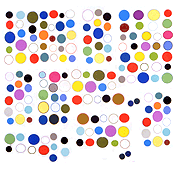Have said before that I'm not married to the animated GIF for "artistic expression" on the web. If at some point only of 40% of browsers, mobile devices, etc read them then it will be time to use something else. It may be by that time the Web will be completely balkanized into Slow Web, Mobile Web, ZuckerWeb, etc., at which point it will make even less sense to fetishize a particular filetype.
In any scenario the best file to make or use is the one that isn't dependent on one company's proprietary scheme. To the extent there's consensus on "open source" standards, that's the way to go. Otherwise you end up with a hard drive or portfolio full of Realplayer files.
So what are some open source alternatives to GIFs if you want to make light-loading, small file, non-proprietary, universally-read animations? The answer is nothing, yet. Here's a list of comparative file types from Wikipedia that I've annotated somewhat:
1. APNG (animated PNG) - only readable by Firefox, Opera, and a handful of others.
2. The MNG file format has less web browser support.
3. The GIF file format "has better application and browser support than APNG, but it is limited to 256 colors per frame and supports only 1 bit alpha transparency, by mapping one of the palette colors to transparent." I could frankly care less about the transparency issues--am not interested in simulating photography or glaze painting.
4. SVG combined with scripting or SMIL can animate vector graphics and can incorporate raster graphics. An .svg file is basically an open source version of the .swf or Flash file. SVGs have pretty wide browser support at this point, but only for still images. SMIL is "not yet native to web browsers." Programs such as Inkscape can be used to make vector drawings but not animations. You can only export drawings as frames and animate them elsewhere. There seems to be disagreement as to how animation would work in Inkscape. One developer wrote:
SVG-animation is compared to a framebased movieeditor like comparing turbo pascal with c++. These are two different worlds or paradigms. You have to relearn your language, because you have to forget to think in frames. Every object, Line, Rectangle, Path has his own time and space. You could move everything on one single path or give every object a different path to move on. Or you could change the size or its color over time. SVG-animation is designed to get animation on mobile devices. Inkscape should focus on those for animation. We certainly need a global-timeline, on which all animated things get a colored representation (a color bar for each object) of their movement in time. There are already programs to render animated svg into a number of png's or animated png. Inkscape must only be conformant to the svg-standard. --SvH 17:13, 28 February 2009 (UTC)
5. Dynamic graphics created with HTML 5 canvas Object -- Animations using canvas are only "anticipated" at this stage.
6. An alternative method for animations in web pages is to use conventional static images and animate them using JavaScript, Adobe Flash, Java or other plugin based technologies. [Forget Flash--but if the point is to have instant browser reading of animations, for the broadest, fastest possible dissemination of weak universal gestures, how "optional" should JavaScript plugins be?]
The vector-based drawing and animation linked to in item 4 are by Duncan Alexander, who is working on his own post about filetypes--I look forward to reading it. He also responded to Man Bartlett's obscurantist GIF rant; I think it's premature to consider the "art or not" provocation before Bartlett answers some basic questions. Especially since Duncan is now in the position of having to explain art after 1968 to one of his regular trolls.
